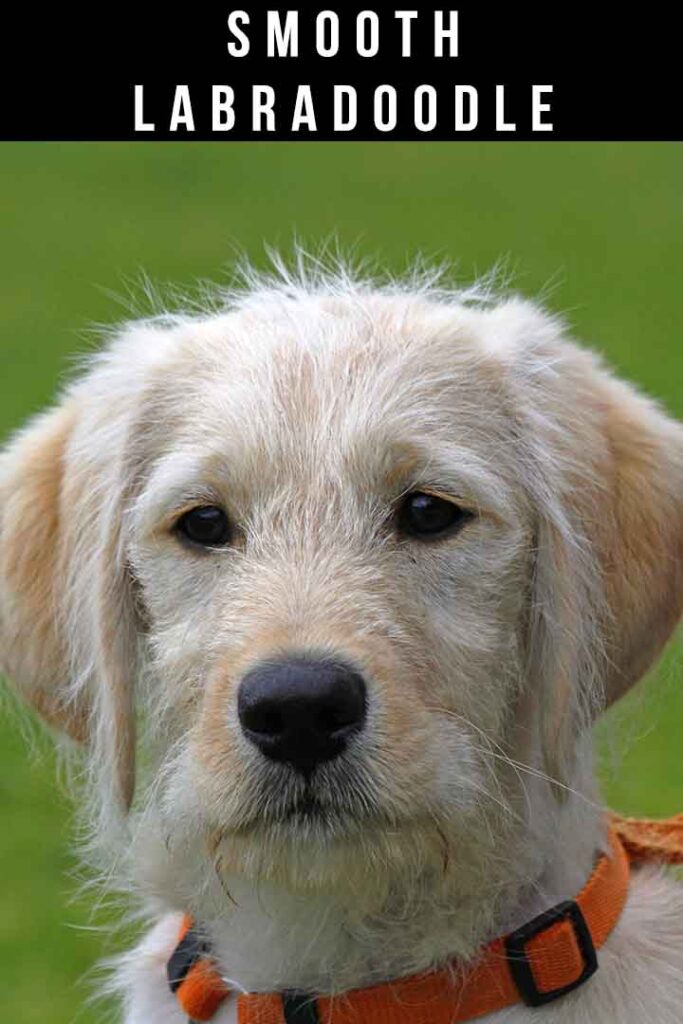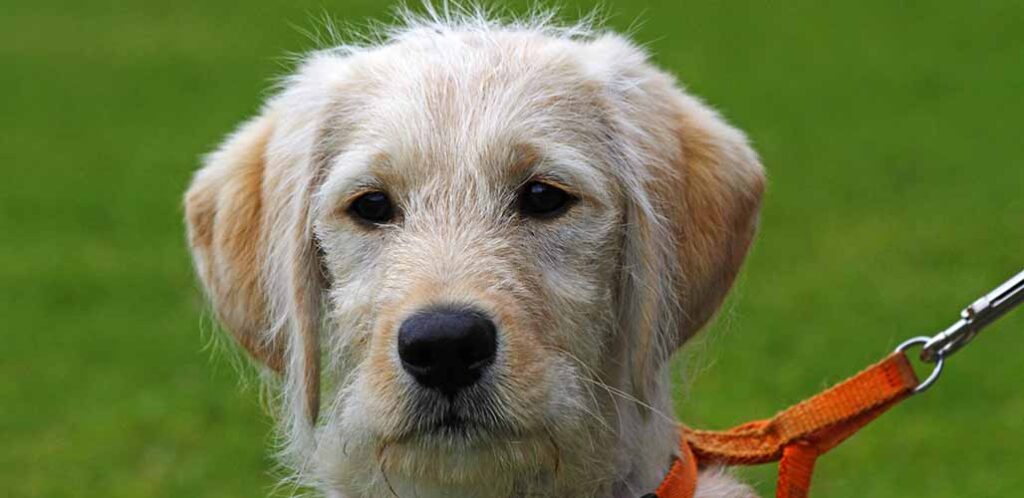This article is a complete introduction to smooth Labradoodle dogs, with relatively short, straight coats. We’ll cover the probability of finding a straight coat Labradoodle puppy, and the differences between caring for smooth haired vs curly haired Labradoodles.
- What is a smooth Labradoodle?
- What does a Labradoodle look like with smooth hair?
- Can Labradoodles start out smooth-coated and turn curly?
- Smooth Labradoodle temperament
- Smooth coat Labradoodle grooming
- Smooth haired Labradoodle vs curly haired Labradoodle
- Finding a smooth coat Labradoodle puppy
A smooth Labradoodle is also known as a straight hair Labradoodle, or a flat coated Labradoodle. It has a coat texture which more closely resembles a Labrador than a Poodle. Owing to the way curly coats are inherited, a smooth coat Labradoodle is most likely to come from an F1b or multigen Labradoodle litter. This can also affect their temperament too.
These home videos of black Labradoodle Franklin growing up show that his coat stays shorter and smoother than the traditional image of a Labradoodle. Let’s find out how that came about!
What is a smooth Labradoodle?
A smooth Labradoodle is a Labrador-Poodle cross, with a relatively short straight coat. Labradors usually have short, straight coats, caused by a gene called Cu+, or the ‘straight coat gene’. Poodles on the other hand have long and tightly curled coats, caused by the CuC gene, or ‘curly coat gene’.
All animals inherit their genes in pairs, one from each parent. Labradors all have two copies of the straight coat gene. And most (if not all) Poodles have two copies of the curly coat gene. First generation Labradoodles get one of each, and since the effects of the curly coat gene are dominant over the effects of the straight coat gene, all first generation Labradoodles have curly coats.
Smooth F1 Labradoodles
The only way a first generation (F1) Labradoodle could have a straight coat is if their Poodle parent was carrying one copy of the straight coat gene. It is possible that small numbers of Poodles do silently carry one copy of the straight coat gene. As long as the number of individuals carrying the straight hair gene remains low, the likelihood of them mating with another carrier and producing straight haired puppies is tiny, so the presence of the straight coat gene can remain hidden for many generations. In a similar example, small numbers of Labradors carry the genes which produce long coats and tan points!
Breeding a Labradoodle dog with straight hair
Smooth coat Labradoodles are more usually the result of either backcrossing, or multigenerational breeding.
- Backcrossing means mating a mixed breed dog with a purebred dog again. Mating an F1 Labradoodle with a purebred Labrador produces an F1b generation of puppies, and approximately half of them will have straight coats.
- Multigenerational breeding means breeding Labradoodles with other Labradoodles. Mating an F1 Labradoodle with an F1 Labradoodle produces an F2 generation of puppies, and approximately one quarter of them will have straight coats. Subsequent generations (for example produced by mating an F1 Labradoodle and and F2 Labradoodle, or two F2 Labradoodles) might also have smooth coated puppies in them, depending on the genetic makeup of the parents.
With us so far?
Great! But at the moment, geneticists still don’t understand all the genes which control dogs’ coat length and texture. So whilst everything we’ve said so far is generally true, there are still sometimes exceptions and surprise results. And as hard as a breeder can try to predict the coats their puppies will have, with mixed breeding it’s impossible to predict which hidden genes might suddenly be revealed!
Smooth Labradoodle vs wirehaired Labradoodle
It’s interesting to note how the term smooth coated is used in Labradoodles compared to other breeds. It can also help you avoid confusion whilst chatting with friends about your dog’s coat type! Among Labradoodles, smooth coated is used as a simple synonym for straight. But in Dachshunds, German Pointers and most terrier breeds, smooth means ‘straight-as-opposed-to-wirehaired’. However, a wirehaired Labradoodle doesn’t exist at all. Wirehair coats are caused by the WhW gene, which isn’t carried by Labs or Poodles.
What does a Labradoodle look like with smooth hair?
An F1b Labradoodle with a smooth coat is likely to look more like a Labrador than a Poodle. If their coat is very smooth, and one of the standard Labrador colors, you might even find that people mistake them for a pedigree Lab.

But a smooth Labradoodle could have a straight coat and a distinctly Poodle-like frame. Labradors and Poodles were both originally bred for the same purpose – to retrieve waterfowl that had been shot on hunts, and carry it back to their owner. So it’s not surprising they have a broadly similar build. However, Poodles tend to be slightly leaner and more ‘leggy’ than Labradors, who are generally a bit more stocky. My own favorite Labradoodle friend has a short, smooth coat, a lean but Labrador-esque face, and long legs like a Poodle – she looks like a supermodel!
Can Labradoodles start out smooth-coated and turn curly?
Have you been expecting a curly Labradoodle, but they’ve come home with a soft, smooth coat? Some Labradoodle’s coats do get much curlier as they age.
All dogs are born with a puppy coat, which is softer, finer, and less shiny than their adult coat. Labradoodle puppy coats are generally shorter, less curly and lie flatter than their adult coat. They will start to shed their puppy coat and gradually replace it with an adult coat from about 6 months old onwards. If there is a known possibility that your puppy will have a smooth adult coat too, your breeder should be honest with you about that from the start. But remember, mixed breed coats can be surprising!
Smooth Labradoodle temperament
Labradoodles have become enormously successful family pets thanks to their winning personalities. They tend to be sociable, good-natured, playful and affectionate. These qualities are common to Labs and Poodles, so Labradoodles reliably have them too. If anything, Labradors tend to be more friendly with other dogs than Poodles are, and less likely to display watchdog or guarding behaviors. An F1b smooth Labradoodle with a purebred Labrador parent has more Labrador heritage overall, and that might also be reflected in their personality too. But a multigen smooth Labradoodle’s ancestry is more complex, and they could have any mix of Labrador and Poodle traits.
Smooth coat Labradoodle grooming
One advantage of a straight coat Labradoodle is that they typically require less grooming than curly Labradoodles. This is especially true of doodles with short smooth coats. But remember that hair length is controlled separately to texture, so your dog could have fur which is smooth and long. If this happens, they might need regular brushing to help remove dirt and debris, even if the hairs don’t tangle easily. Long Labradoodle coats in all textures are especially prone to matting between 6 months and a year old. This is because the soft baby coat tends to get caught up and tangled in the coarse adult coat as it falls out. So pay special attention to grooming during this time.
NOTE: Short straight coats should not be shaved or clipped except as part of medical treatment, as they may not grow back properly.
Do smooth coat Labradoodles shed?
Smooth coat Labradoodles are more likely to shed than a curly coat Labradoodles, although they may still shed less than purebred Labs. Regular brushing can make a big difference to how much fur ends up on your sofa!
It’s important to bear in mind that non-shedding does not equal non-allergenic. The protein molecules which trigger an allergic reaction in dog allergy sufferers actually come from their saliva (and to a lesser extent their sweat and urine) not their hair. So a smooth Labradoodle is no more allergenic than a curly or wavy Labradoodle, and none of them are truly hypoallergenic.
Smooth haired Labradoodle vs curly haired Labradoodle
A straight coat Labradoodle isn’t usually what people are expecting when they consider this mix as a pet. So let’s compare them to each other.
Smooth haired Labradoodles:
- May have a more Labrador like temperament, depending on their ancestry.
- Are likely to shed more.
- But will carry less muddy water home at the end of a walk.
- Need less day-to-day grooming.
- And don’t need their coat clipping.
Curly haired Labradoodles
- Look more teddy bear-like.
- Shed less.
- Need regular brushing every few days.
- Need clipping several times a year.
- But aren’t necessarily hypoallergenic.
If you’re been won over by the Labradoodle temperament, but you prefer the idea of a short smooth coat to a long curly one, let’s take a look at how you could find one.
Finding a smooth coat Labradoodle puppy
The most reliable way to secure a smooth Labradoodle is to put yourself on the waiting list for a puppy from an F1b litter with a pedigree Labrador parent, or an F2 litter. Even though the first option would produce a high proportion of smooth puppies, it’s likely to be the harder one to find. That’s because breeders usually use pedigree Poodles for F1b litters instead, to increase the odds of a non-shedding coat instead.
Since Labradoodles are a mixed breed, it’s likely you’ll have to rely on word of mouth to find a breeder. Look for breeders who health test their breeding dogs for
- Hip Dysplasia
- Elbow Dysplasia
- Eye Examination
- And Exercise Induced Collapse
Do you have a smooth Labradoodle?
Did you expect them to have a smooth coat, or was it a surprise? Tell us about them in the comments box down below!
Before you go, don’t miss these articles about living your best life with your doodle dog:
- Labradoodle Swimming
- Ages & Stages in Labradoodle Puppy Training
- Life with a Labradoodle and Kids
- F1b Labradoodle – What Does It Mean?
- F2 Labradoodle – What Does It Mean?
- Flat Coated Labradoodle
References
Ali et al. Genetic analysis of the modern Australian labradoodle dog breed reveals an excess of the poodle genome. PLOS Genetics. 2020.
Cadieu et al. Coat Variation in the Domestic Dog Is Governed by Variants in Three Genes. Science. 2009.
Ostrander. The Genetics of the Dog, 2nd Edition. CABI Publishing. 2012.
Salmela et al. A novel KRT71 variant in curly-coated dogs. Animal Genetics. 2018.
Vredegoor et al. Can f 1 levels in hair and homes of different dog breeds: Lack of evidence to describe any dog breed as hypoallergenic. Journal of Allergy and Clinical Immunology. 2012.

